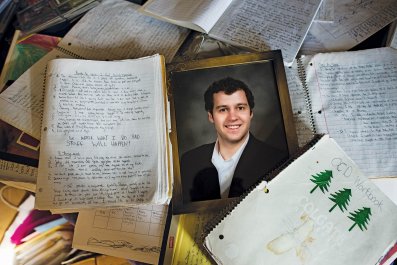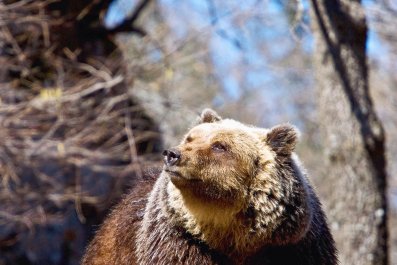Ants are strange creatures. They're as old as dinosaurs (they've been around for about 120 million years), and an estimated 10 quadrillion of them are on the planet. They can lift up to 100 times their body weight and they can pull carbon—one of the greenhouse gases that's warming the planet—out of the atmosphere.
This last trick is an unintentional consequence of their home-building skills: As they dig tunnels, they bore through anything that gets in the way, even minerals. And when they hit calcite, they break it down into calcium, which combines with carbon from the air and re-forms as limestone.
That's a scenario that will perk up the ears of any climate scientist. With the Earth warming at a rate 10 times faster than the heat-up after the last ice age, scientists are looking at anything they can use to stop climate change. Even insects.
The term geoengineering—harnessing Earth's natural systems for planet-wide change—dates back to at least the early 1970s. Even then, scientists were concerned about what the release of carbon dioxide from power plants was doing to the Earth's atmosphere. Among other ideas, they proposed capturing the waste carbon from Mediterranean power plants and injecting it into the fast-moving ocean currents at the Strait of Gibraltar, which would carry it out into the deepest parts of the Atlantic Ocean, where it would effectively be sequestered.
This plan never came to pass, primarily because of concerns about what the sequestered carbon would do to life in nearby waters. But it did spark the imagination of the world's climate scientists. If we can't—or won't—curb our use of polluting energy systems, and climate change gets so bad that it threatens human life on Earth, are there ways we can use our planet's own systems to reverse the damage we've done to avoid doomsday?
At this point, it's almost universally recognized that quick action is needed to curb the changing climate. The amount of carbon in the atmosphere has been rising steadily since the Industrial Revolution, and it's clear that humans need to cut down on greenhouse gas emissions. There have been some moves in that direction. Just last month the U.S. and China signed a landmark climate agreement that would have both countries reduce their emissions by 26 percent and 20 percent, respectively, by the year 2030. China, for its part, is planning a large push into research on carbon capture and storage—a geoengineering feat in itself, in which power plants and other carbon-emitting facilities capture their carbon dioxide emissions and inject them into the ground.
However, to reverse the damage that's already been done, emissions from all countries would need to be cut back by a lot more than 20 percent. And, to date, the world can't quite agree on committing to more drastic changes, despite almost 20 years of negotiations toward a global climate agreement. Many are hopeful that the China-U.S. accords will help push these negotiations toward a resolution at this year's United Nations Climate Change Conference, currently under way in Lima, Peru.
In the meantime, the world's climate scientists have begun to turn their attention to generating workable geoengineering projects that can either bypass governmental red tape or reverse the change so quickly and with such great efficacy that it might not matter if the world never manages to get its act together.
Today there are a slew of ideas for geoengineering the planet. They range from the very simple to the very sci-fi. But they're all based in science, and they could one day be the last chance to save the human race. What follows is a sampling of each. Some are more realistic and better developed than others, but all have the potential to help slowly over time or quickly in one fell swoop.
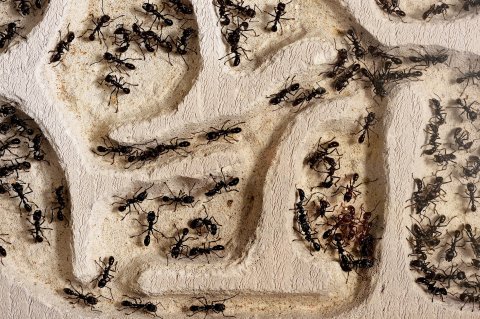
Tiny Carbon Footprints
The discovery that ants capture carbon was made just this year by Ronald Dorn, a geomorphologist at Arizona State University, but it arose from an experiment that has been ongoing for 25 years. Dorn was studying how different materials decay in order to better understand the processes that create Earth's topographical features. For example: What makes a certain type of rock erode into, say, the Grand Canyon?
In one of Dorn's studies, he took basalt (formed when lava cools) from Hawaii and buried it in the ground in a place far from its native habitat: the Catalina Mountains in Arizona. The idea was that he could come back to study the deposit years later and look for evidence of the basalt in areas around the initial deposit to see how it had spread.
When he returned to the mountains of the U.S. Southwest around 20 years later, he found that throughout the area, the lava rock was breaking down into calcium and then combining with carbon in the air to re-form as limestone. He also noticed that in the spots where ants lived, that process was happening significantly faster.
Dorn turned to some colleagues who study ants, and they told him biologists have known for years that ant nests tend to have a lot of limestone in them. But before Dorn's research, biologists thought this was simply because the ants were carrying it in. Now they knew the bugs are actually creating it.
The mechanism for carbon capture is still a mystery, but Dorn thinks that if we could figure it out, it could be replicated in a synthetic way. Imagine garden walls built out of material that quickly breaks down, captures carbon from the air and re-forms as limestone.

Born Tree
It's not crazy to think humans could come up with ways to change the makeup of the planet; after all, humans have already reengineered the Earth by accident. Across the planet we've torn down carbon-capturing forests to make room for farms, so we could feed our growing populations. And David Edwards, a professor of conservation science at the University of Sheffield, is starting to think that one of the best ways to geoengineer the planet is to figure out a way to bring those forests back.
When he went to the tropical Andes Mountains of South America to talk to farmers about their experiences working the land, he found that it wasn't at all uncommon for the locals to try to sell him their farms. "They physically manhandled me, in a nice way, begging me to buy their farms," he says.
That's because, despite being one of the most biodiverse places on the planet, the Andes are a terrible place for agriculture. They are steep, wet and cloudy. Most farmers who work the land there produce just enough to feed themselves. For the most part, they farm cattle, with maybe a small vegetable patch here and there. Their cows are skinny, because there's not much grass and the terrain is hard on the animals. "Many of these farmers are running at a loss. They're in a poverty trap, and they lack bank accounts. Their cow is their bank account," he says.
This harsh reality led Edwards to a simple solution that can combat climate change—return the biodiversity stripped from the region by years of over-farming—and even earn the farmers some money: give them carbon credits for abandoning agriculture and returning the land to its natural state. Paying farmers as little as $1.99 per ton of carbon dioxide reduced (a huge discount compared with the $7.80 per ton average paid globally for permanent carbon credits in 2013) would be enough to convince the Andean locals to shut down their cattle farms.
In their place, new-growth forests would come back naturally (most of the cattle farms were the result of clear-cutting old-growth forests to create pastures for grazing). And these new-growth forests would very rapidly begin to capture carbon from the atmosphere. The farmer is essentially paid to ensure that the forest comes back to life—that people keep their cattle off of it, don't plant on it and that it's healthy enough to begin capturing carbon, Edwards says. "And we can gain massive biodiversity benefits as an unintended consequence. It would re-colonize the forest as it regrows and get more connectivity between landscapes and help reduce extinction risks."
Already, nongovernmental organizations (NGOs) are investing in property around the world in an attempt to protect endangered lands. In some places, they are attempting to buy or rent land from logging companies that would otherwise tear down entire sections of forest. In places like the Borneo rain forest, the trees are so valuable to logging interests that to buy them out could cost NGOs as much as $28 per ton of carbon. Compared with that, renting farmland in the Andes is a real bargain.
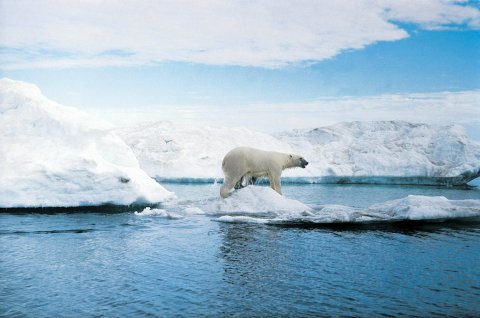
Walking the Plankton
The world's oceans have countless tiny organisms called phytoplankton. Also known as microalgae, these itty-bitty plants eat carbon dioxide from the water and release oxygen into the ocean as a by-product. Once the phytoplankton blooms take up the carbon from the ocean's surface, they sink down to the deep ocean, where the carbon is effectively sequestered. They're so productive that scientists think phytoplankton produce about 50 percent of the oxygen humans breathe.
If we could get phytoplankton to boost their uptake of carbon, it could have a huge global impact—and would be very simple to do. When the tiny plants get a boost of nutrients from the water around them, they eat a lot more carbon. And right now the oceans of the world are low in one particular nutrient—iron—although scientists aren't sure why. So the phytoplankton aren't nearly as active as they could be. In fact, when big storms blow iron-rich dust into the oceans, satellites see evidence of phytoplankton blooms in areas where they normally aren't visible.
Over the past decade there have been more than 12 small-scale experiments in which scientists (and one rogue California businessman named Russ George) dumped iron dust into the ocean to test the hypothesis that phytoplankton could be triggered to wake up and start devouring mass quantities of carbon. All of the experiments (except George's) showed that there was some benefit to seeding the ocean with iron.
Victor Smetacek, a biological oceanographer at Germany's Alfred Wegener Institute for Polar and Marine Research, contributed to one such study in 2009. Though he says there needs to be a lot more research into ocean seeding, he believes it's a very promising option. "I'm talking about using a natural mechanism that has already proven itself," Smetacek says. "We need to harness the biosphere and see where we can apply levers to lift the carpet and sweep some of the carbon under."
Oddly, however, the ocean-seeding option seems to be a controversial one. Smetacek says that although he believes strongly in its benefits, it has never been a popular option among climate scientists. "This ocean iron fertilization is highly unpopular with technocratic geoengineers because it involves biology. But we have to get the biosphere to help," he says. "The only thing we can do is try and nudge the biosphere as much as possible and try to open up as many carbon sinks as possible."
One naysayer is Stanford professor and environmental scientist Ken Caldeira, an expert on geoengineering. He doesn't think ocean seeding will work at scale. Geoengineering projects that remove carbon from the atmosphere, he says, are very slow and take huge amounts of effort. On top of that, "the removal program has to be enormous." Essentially, Caldeira says, to effectively sap enough carbon out of the atmosphere using phytoplankton, scientists would have to create a program that spans the entire globe.
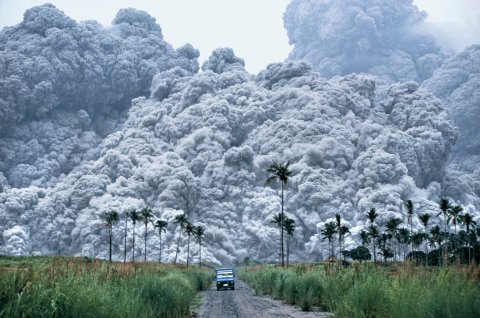
Seed the Sky
Caldeira, who is currently on a National Academy of Sciences panel writing a report about geoengineering, says there's really only one good option and that's using man-made technology to mimic the world-cooling effects of a volcanic eruption.
When a volcano erupts, it shoots massive amounts of particles into the sky. These particles include sulfates—variations on the chemical sulfuric acid—that then spread out through the lower atmosphere and hang around for several years. While they're there, the sulfates absorb radiation coming to Earth from the sun, which in turn cools off the planet. In 1991, when Mount Pinatubo in the Philippines erupted, the Earth cooled by 0.9 degrees Fahrenheit over the next few years. It's a phenomenon that has been seen many times throughout history; there is a record, for example, of an 1815 Indonesian eruption that caused the following year to be dubbed "the year without summer."
Caldeira says that by sending a fleet of planes into the sky and spraying the atmosphere with sulfate-based aerosols, we could have a speedy, cost-effective method to cool the Earth. The sulfates would eventually fall out of the upper atmosphere and end up close to the Earth's crust, but it's probably not a major concern, Caldeira says. The sulfates would be thousands of times smaller than the air pollution around cities like Beijing or Shanghai, and they wouldn't cause any increase in acid rain.
That said, Caldeira doesn't believe any method of geoengineering is really a good solution to fighting climate change—we can't test them on a large scale, and implementing them blindly could be dangerous. On the other hand, he says, "I'm negative about all the geoengineering options, but I'm also negative about jumping out of burning airplanes with a parachute I've never tested before. I'd still rather have the parachute than not have it."

Man Unmade
Most climate scientists still argue that instead of relying on untested attempts to remake the natural world we've unmade, humans might want to take a look at themselves. The way people live in the developed world—suburban sprawl, red meat, globe-hopping air travel—places a tremendous environmental burden on the planet. The middle class of population-dense countries like China and India are becoming, culturally, more and more like Western Europe and North America, and that burden continues to increase. Reversing the damage we've wrought is one piece of the puzzle; the other is halting future impact. That, however, would take a seismic shift in what has become a global value system.
Or, perhaps, a reimagining of what it means to be human. In a paper released in 2012, S. Matthew Liao, a philosopher and ethicist at New York University, and some colleagues proposed a series of human-engineering projects that could make our very existence less damaging to the Earth. Among the proposals were a patch you can put on your skin that would make you averse to the flavor of meat (cattle farms are a notorious producer of the greenhouse gas methane), genetic engineering in utero to make humans grow shorter (smaller people means fewer resources used), technological reengineering of our eyeballs to make us better at seeing at night (better night vision means lower energy consumption), and the extremely simple plan of educating more women (the higher a woman's education the fewer children she is likely to have, and fewer children means less human impact on the globe).
Geoengineering, Liao argues, doesn't address the root cause. Remaking the planet simply attempts to counteract the damage that's been done, but it does nothing to stop the burden humans put on the planet. "Human engineering is more of an upstream solution," says Liao. "You get right to the source. If we're smaller on average, then we can have a smaller footprint on the planet. You're looking at the source of the problem."
It might be uncomfortable for humans to imagine intentionally getting smaller over generations or changing their physiology to become averse to meat, but why should seeding the sky with aerosols be any more acceptable? In the end, these are all actions we would enact only in worst-case scenarios. And when we're facing the possible devastation of all mankind, perhaps a little humanity-wide night vision won't seem so dramatic.












